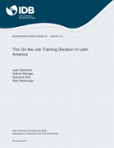The On-the-Job Training Decision in Latin America
Date
Nov 2017
Using data from the World Bank’s Enterprise Survey, this paper explores the determinants of firms’ training decisions in Latin America and the Caribbean. The share of production for the export market and the size of the firm are key factors; training programs are not prevalent in all sectors. In addition, the share of workers receiving training depends on the age of the firm, and only for non-productive workers are differences observed across sectors. More detailed data from a Longitudinal Enterprise Survey in Chile are used to corroborate these findings. It is found that the percentage of workers receiving training is low and that the extensive and intensive margins of training are affected by different sets of firm characteristics. Finally, the results of a qualitative study in Chile suggest that training is mostly introduced to comply with certifications and standards imposed by domestic and foreign authorities. Training in larger firms may also be oriented to improve the work environment.




